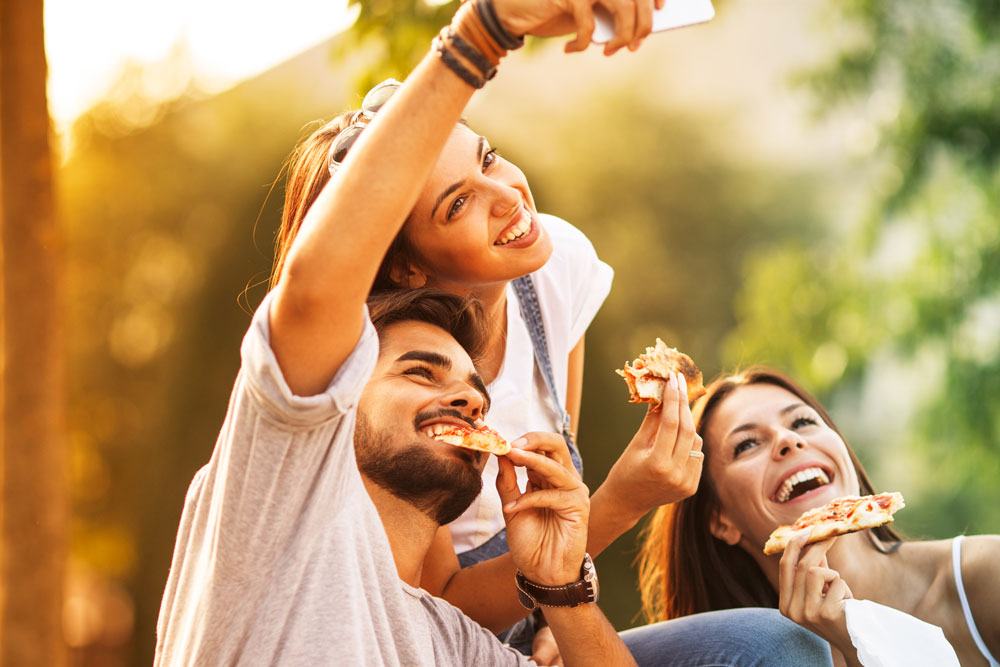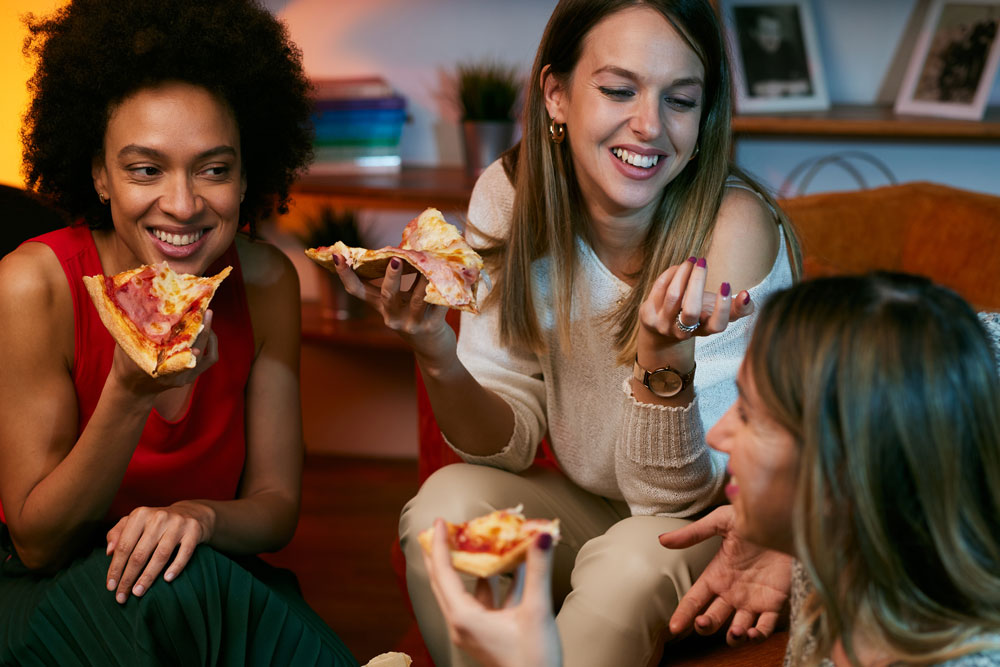By Tracy Morin
Loyalty programs were once a novelty, but for many businesses, including restaurants, they’re now a necessity. “A loyalty program is table stakes—everyone out there is doing it, and guests expect it,” notes Hope Neiman, chief marketing officer at Tillster in Los Angeles. “It’s a great opportunity to stay connected to guests, track their data, and use that data to bring them back.” Here, bright minds in the business offer up creative loyalty ideas to make your program a success.
“Integrate the loyalty program with online orders….Not doing so might have the opposite of the desired effect: disappointing your customers.”
—Nick Mirev, BlueCart

Many pizza brands add visual elements to their website, app and online ordering—as well as their loyalty program—to further engage customers.
GODFATHER’S PIZZA
Isaiah Melendez, Director of Business Development, Pizza Patrón, San Antonio, TX
Back in 2016, we were probably using a small fraction of our Revel POS’s capabilities—it was like a glorified cash register. When Charles Loflin and Chris Partyka bought the company [in 2016], we started bringing in some data analysts to help configure and take advantage of the open API (application programming interfaces). We’re acquiring and taking advantage of data straight from the API, learning how to acquire the data and what to do with it. We brought the raw data over through Revel Data Connector recently. In doing that, we’ve been able to make ad hoc reports and get very granular in what we want to see.
Rob Elliott, executive vice president of marketing, Hungry Howie’s, Madison Heights, MI
We’re heading into the seventh year of our loyalty program. We started it because of the 80-20 rule, which says that 80% of your sales are coming from 20% of your most loyal customers. Before we launched, we looked at competitors and at our customers. We keep it super simple and very easy to understand: Each visit of $10 or more earns a slice (so to speak) of a six-slice pizza, so after six visits you get a free medium two-topping pizza.
The customer can redeem points in-store or online. We have a very visual app, so they can go on and look anytime at how close they are to their next reward. They can even bank pizzas for later, but most customers redeem them as they’re ready. We send a dynamic code with the immediate opportunity to order or to use for their next visit. At the store level, the rewards will pop up for our employees to see as well. It’s been really successful, and we watch the metrics closely: what rewards are sent, how many are redeemed, etc. We can check those stats every day or every week.
We get great data in the pizza category, and as long as customers leave the privacy policy box checked (it is pre-checked when they register, and they have the option to uncheck), we can market to them through email, SMS or MMS (multimedia messaging service) texts, as well as through digital platforms like paid search and social media. With our POS company, HungerRush, loyalty is an add-on application, and we pay a monthly subscription fee. The POS, app and loyalty program are all tied together.
We believe it’s important to celebrate that 20% of loyal customers, to communicate with them, and offer a program for them to stay passionate about our brand—because there can be a lot of brand-switching with pizza. I know some of our own staff members don’t go to pizza or fast-casual restaurants that don’t offer a loyalty option.
Related: Here’s how Domino’s has boosted its loyalty rewards program

Getty Images/BalanceFormcreative
Stefan Campbell, owner, The Small Business Blog, Phoenix, AZ
Gamification is a great way to make your brand unique in terms of customer experience and provide tailored benefits that make you stand out. Gaming is fun, and everyone loves a good friend to play games with—make your restaurant one of those good friends!
Implement gamification elements into the loyalty program through the POS system. From mobile app integration to website-exclusive games and even in-person experiences, find unique and interactive elements that can make your loyalty program more engaging and fun for customers. Rather than earning simple points in the way that most other restaurants do, consider something more exciting, like leveling up, unlocking achievements or participating in challenges; find a niche approach specific to your brand.
It’s essential for restaurants to regularly analyze data provided by their POS system and make informed decisions to improve their loyalty program over time. If you implement a gamification strategy, regularly provide new styles of game play and challenges, keeping the experience fresh. Whether it’s weekly or monthly new games or different styles of gaming for different types of rewards, adjust the experience according to customers’ feedback and expectations.

Hungry Howie’s encourages loyalty program signups with free bonus points and an easy-to-use system for customers to track their rewards.
Hungry Howie’s
Nick Mirev, content marketing specialist, BlueCart, Shingle Springs, CA
Here are my top tips for a winning loyalty program:
- Choose a POS solution with built-in loyalty functionality. This will allow you to manage the loyalty program rules more easily.
- Define the loyalty program’s structure. How can customers earn loyalty points? How can they redeem them? If you were a customer, would that loyalty program look interesting to you?
- Configuration: The rules of the loyalty program need to be integrated with the POS system. Then it’s much easier to monitor and analyze customer data. This can determine future seasonal promotions or optimize the loyalty program.
- Integrate the loyalty program with online orders. With the rise of online ordering, this is a must. Not doing so might have the opposite of the desired effect: disappointing your customers.
- There’s no point in having a loyalty program if you don’t promote it. Promote via online channels such as social media, email and website. Additionally, members of the team, such as waiters and bartenders, should know all details regarding the loyalty program in order to promote it to customers.
Jon Morgan, CEO, Venture Smarter, Cincinnati, OH
With the data collected through the POS system, restaurants can analyze customers’ buying patterns and preferences to offer tailored rewards. For example, provide discounts or free items on the customer’s favorite dish or beverage. By making the rewards relevant and meaningful to individual customers, restaurants can build a strong bond and increase the likelihood of repeat visits.
Another approach is to introduce elements of gamification, such as points, levels or badges, to make the loyalty experience more engaging and fun. They can create challenges or contests where customers can earn bonus points or exclusive rewards. This interactive approach not only encourages repeat visits but also generates a sense of excitement and competition among customers, fostering a deeper connection with the restaurant.
Integrating mobile applications or loyalty apps with the POS system allows customers to conveniently track their rewards, receive personalized offers, and easily redeem them. This seamless and user-friendly experience will not only make customers feel valued but also provide them with a hassle-free way to participate.
Hope Neiman, chief marketing officer, Tillster, Los Angeles, CA
Some POS systems can do loyalty programs, and some are not equipped to, in which case loyalty is attached as an extra service. Some have APIs to make that seamless.
We handle the Godfather’s Pizza loyalty program, and customer data allows us to segment populations. For example, you might want to reach out to customers who haven’t visited in a while. Or, if they order a small pizza every time, you can market a medium to them. You want a mix of offers—for things they always order and things that they don’t. In the old days, people often chose to market something very different, but if you do that too much, guests think you don’t understand them. Yet you want to upsell and cross-sell—like if they order meat pizzas and you have a new bacon topping, that’s a great opportunity.
Try to make a loyalty offer that’s achievable but still expanding. Let’s say one group never spends more than $15; send an offer to spend $17.50 or more. For $25 spenders, $28. You don’t want to give a $17.50 offer to a $25-or-more group. Or if a guest comes in once quarterly, give them a bounce-back offer to return the next month. You might get them in one more time per year.
“A loyalty program is table stakes—everyone out there is doing it, and guests expect it.”
—Hope Neiman, Tillster
Build your loyalty program with “extra currency.” Say you need guests to return 10 times; make the redemption goal 12 purchases. That way, after the third or fourth visit, you can say, “Your next visit will count as two.” It gamifies the program and builds loyalty, because people have that FOMO—fear of missing out.
Make sure to capture emails, though you can also market through text or push notifications. You don’t need to offer just discounts; maybe you have a new LTO and you offer them to come in and try it first. They feel special, which builds an affinity to your brand. Let them know you appreciate them. When they place an order, don’t just say thanks; say, “You’re X closer to your next reward!”
Finally, many use loyalty to give back: “Vote for your favorite local school/charity/sports team and we’ll donate 50 cents per order to them when you purchase.” It changes how people feel when they think they’re helping—especially among younger consumers.
Tracy Morin is PMQ’s copy editor.













